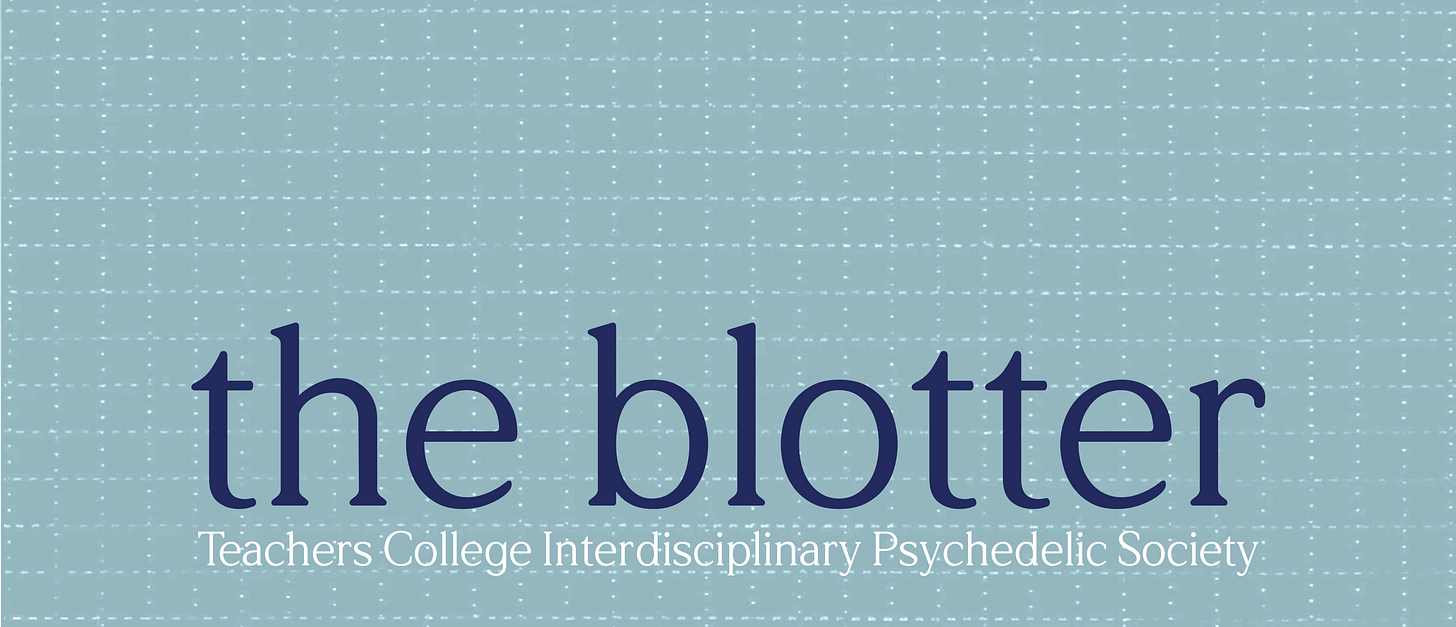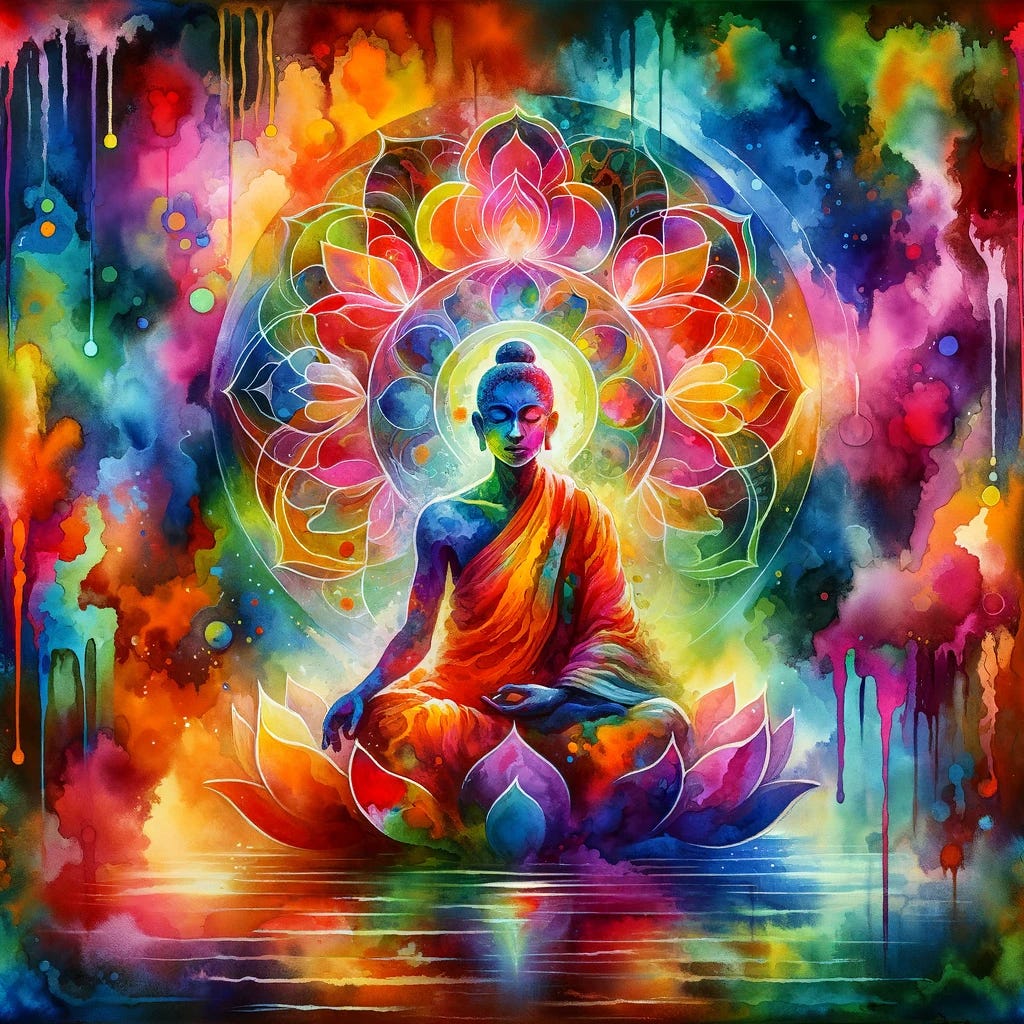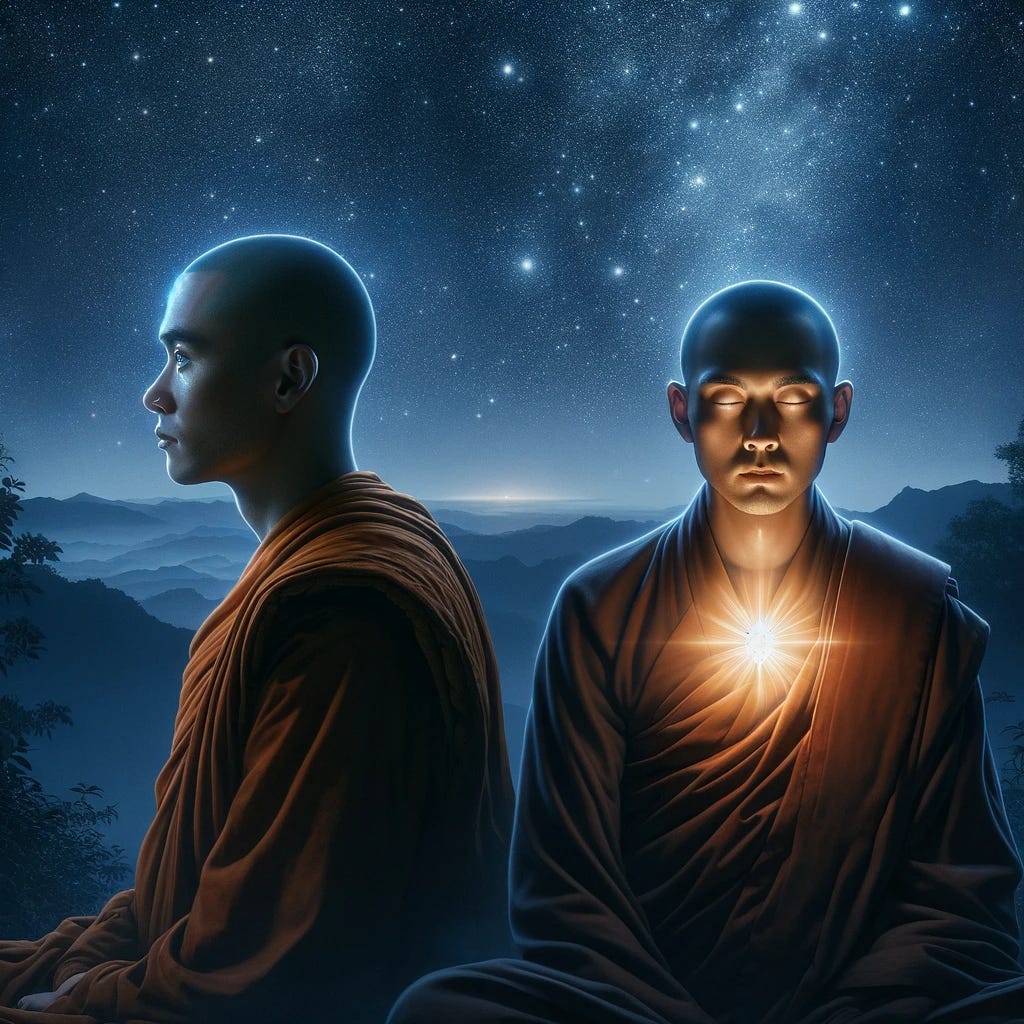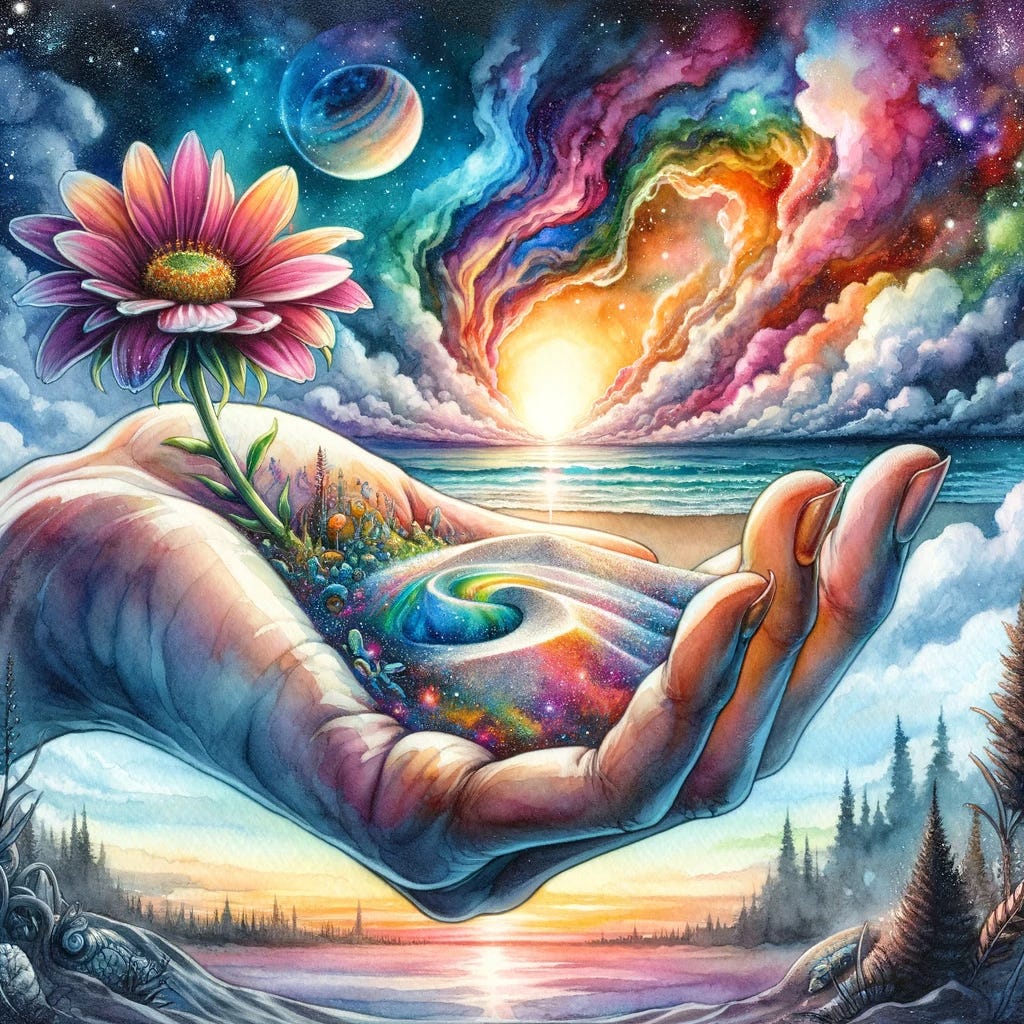If you are reading this article, you are probably aware—at least to some extent—of the current renaissance in psychedelic research. Increasingly, the question is no longer if these compounds will become legal therapeutic tools, but when. As psychedelics approach their official rebirth in the therapeutic space, some researchers have become interested in how to optimize their effectiveness. One frequently cited tool that might enhance the efficacy and safety of psychedelic therapy is meditation, in the Western world most often viewed through the lens of mindfulness practices. Broadly defined, mindfulness awareness is characterized by an open, non-judgemental, and present-moment awareness of one’s internal states and surroundings. And indeed, there have been many conceptual and experimental contributions to this suspected synergy. I myself have tried to gain a better understanding of this topic in my bachelor thesis which aimed to assess the impact of a mindfulness intervention before individuals attended a psychedelic retreat in the Netherlands.
In this context, however, I think it is important to consider one fact: Our understanding of meditation is largely influenced by Buddhist practices. Of course, long before individuals like Jon Kabatt-Zinn and others made these practices available to a Western audience, meditation was a fundamental part of Eastern spiritual and religious movements. And while mindfulness meditation has undoubtedly been helpful to people, I think a large body of wisdom was lost in the act of translating it from East to West. This is because mindfulness—once part of a larger ecology of systematic practices in Buddhism—nowadays often remains an isolated exercise. Thus, many have argued that we are unaware of the broader benefits that mindfulness could afford us. In the following article, I want to explain the role of psychedelic experiences in Buddhist practice and how each might inform the other so that we can cultivate a deeper understanding of both.
What are psychedelic experiences?
Before we dive in, it is a good idea to define what a “psychedelic” experience is. Nowadays, the definition has become a bit vague. In the general population, the word is often used to describe something that is “colorful,” “weird,” or “trippy.” But that's not a clear definition of an experience; any experience can be colorful, weird, or trippy without being psychedelic. Others might say that defining psychedelic experiences is pretty straightforward: they are simply the experiences that arise after you take a psychedelic drug. That, however, can very easily become a circular definition. If psychedelic experiences are those experiences that are occasioned by psychedelic drugs, and psychedelic drugs are those which illicit psychedelic experiences, then we have not actually defined anything.
We need an external referent to base our definition on. Here, the etymology of the word might give us a good direction. Coined by Humphrey Osmond, the term “psychedelic”—derived by combining the ancient Greek words “psyche” and “delos”—means mind-revealing, or mind-manifesting. Thus, we will go with the definition that:
Psychedelic experience = Mind-revealing experience.
But what exactly does it mean to have an experience where the mind is revealed? Of course, there are several viewpoints to be considered, but for the sake of brevity, I will explain the stance taken by philosopher Aidan Lyon, on whose work the following explication will be based. He argues that a psychedelic experience occurs when unconscious content, which is usually inaccessible to our awareness, is suddenly brought up into waking consciousness so that it can be experienced. What I find so cool about this definition is that it is not only relevant to psychedelic drugs, but can be applied to many other events in everyday life.
Most people are aware of the tip-of-the-tongue phenomenon. This happens, for instance, when you’re trying to remember the title of a movie you watched recently—but at that moment, you just blank. “What’s that movie called again, with that mouse that can cook … ?” You’re sure that you know it and you can almost feel it rolling off your tongue but you just can’t remember. Ironically, the harder you try to recall and the more you concentrate, the more it seems to slip away from you. Then, two minutes later, after you’ve moved on and think about something else, suddenly it pops into your head: “Ratatouille!”
In that exact moment, you’ve just had a mini psychedelic experience. Something inaccessible just moments ago—in this case, a specific semantic memory—has suddenly appeared in your awareness.
So what? Is that all psychedelics do? — Bring up names of films in your head. Of course not, drug-induced psychedelic experiences are way more powerful than that. It is like comparing a homeless person and a billionaire. There lies a world between them but their difference can be measured along one dimension: money. Similarly, tip-of-the-tongue experiences and drug-induced psychedelic experiences are also hugely different. Nevertheless, they are still on the same continuum: revelatory experience.
And indeed, there are a large number of experiences that are situated somewhere in the middle of these two. For example, when you have an emotional insight: “Oh … I’m not actually angry—I’m just really scared.” Or maybe: “Wait, it's not really about them showing off. It's about me feeling insecure.”
But what does it mean for one experience to be more revelatory than another? This is where Lyon’s concept of “psychedelic space” comes in. In short, an experience can be more or less psychedelic depending on where it lies on four dimensions. These dimensions are: (1) Scope: how much is revealed (2) Clarity: how detailed and true is the revelation (3) Duration: how long is it revealed for and (4) Novelty: how new is the revelation to you.
Using these ideas, we now have a relatively good grip on what it means for an experience to be psychedelic. If something in your unconscious—that is usually difficult to access for you—is brought into your awareness and has a lot of content, is clearly detailed, stays in your awareness long enough for you to process it, and is something that you have never (or only very rarely) encountered before, then you’ve had a pretty powerful psychedelic experience. Psychedelics then are these kinds of substances which reliably evoke such experiences in people.
Buddhism
Buddhism, with its profound insights into the nature of mind and reality, offers a rich context for understanding the transformative potential of such experiences. Historically, there is no concrete evidence to suggest that traditional Buddhist practitioners routinely engaged in the use of psychedelic substances. However, the essence of psychedelic experiences, as previously defined, resonates deeply with the teachings and practices of Buddhism. The following quotes show as much:
Everyone without exception holds on to the jewel that glows in the night. […] Unless we turn the light within to illuminate the self, how can we hold fast the jewel when we are lost in the outlying countryside? — Eihei Dogen 1200–53
The thinker is the mind and the thought-of is the environment. Mountains, rivers [...] and so forth; reverse your thought to think of the thinking mind—are there so many things there? You people should all turn back your light and reflect; do not memorize my words. Since beginning-less eons you have turned your backs on the light and plunged into darkness; the roots of your false conceptions are deep. — Yangshan Huiji 807–837
In both instances, there are references to “jewels that glow in the night” that we can find if we “turn the light within to illuminate the self.” But too often we “turned [our] backs on the light and plunged into darkness.” Important here is the emphasis on not simply recognizing that this is the case but doing something about it: “You people should all turn back your light and reflect; do not memorize my words”
In Buddhism, such revelatory experiences are therefore often pursued not through external means but through rigorous mental training. Meditative practices are designed to cultivate heightened states of awareness and insight. These practices enable practitioners to explore the depths of their consciousness, revealing the interconnectedness of all things and the impermanent nature of reality.
At the core of Buddhist teaching lie the Four Noble Truths. I will present them here how they are commonly translated into English:
1. Dukkha: All of life is suffering
2. Samudaya: The root cause of suffering is attachment
3. Nirodha: The Cessation of Suffering is Attainable.
4. Marga: The Eightfold Path is the path leading to the confinement of Dukkha
But what exactly is meant by Dukkha? Are we really suffering when we go down to the pier and buy some ice cream for our nephew and see a beaming smile appear on his face? How about when we ask our crush out for a date and they—against all the odds— say yes? When we hold a newborn baby in our arms. Where is all the suffering then?
And if we let go of all things, if we are no longer attached to anything, won’t we be cold and uncaring? No longer care about our friends or family members?
We will return to the Four Noble Truths later in this article to explore their implications further. For now, let me just say that psychedelic experiences, whether natural, through meditation, or psychedelic substances, might give us a deeper understanding of what these truths are trying to get at.
Synergies between psychedelics and meditation
Understanding how meditation and psychedelics can be synergistically transformative begins with recognizing the importance of attention. Here are two important points to keep in mind for the following arguments:
1. Attention augments our cognition: It turns seeing into watching and hearing into listening.
2. Attention is a limited resource.
In a multitude of scientific studies, meditative practices have been shown to help us control where we focus our attention and augment how much we notice when we do so. One way they do that is by training us to deliberately perform transparency-opacity shifts.
Great, another technical term. Not to worry, the following metaphor will be useful in illustrating the concept. Think of a pair of glasses. You might notice them when you first start using them.
But after a while, especially if you’ve been wearing them all your life, they become so integrated into your experience that you don't even realize they are there anymore. You’re simply looking through the glasses into the world as if they didn’t exist. However, if you want to analyze the lenses—to see if there is some dirt on them—you take off your glasses and look at them.
This is what mindfulness, also called vipassana meditation, does. Instead of always looking through our senses at the world, we take some time to take off our glasses to start looking at our senses—often our breath. Similarly, if we practice long enough, it helps us discern if there is any schmutz on our lenses—if there are any distortions in the way we perceive. Additionally, we start to notice the constitutive elements of our experience. By focusing and looking at our sensations (our breath, how our stomach feels when it expands, how that affects the feeling in our ribcage, a grumble in our tummy, a feeling of heat in our chest, etc.) we start to break up the totality, or gestalt, of our experience. Instead of everything being an integrated whole, we chunk our experience into small features and can notice things in more detail.
If we become very skilled at scaling down—taking a step back by looking at instead of through and breaking our experience into features—we might reach a form of altered state of consciousness referred to as a Pure Consciousness Event. We have stepped so far back that we can’t go any further. All we are is pure consciousness.
However, as I have alluded to before, this mindfulness meditation is only one kind of meditation. And as you might have figured, instead of looking at and breaking down, we can also practice looking through and scaling up. This facet is often the cornerstone of contemplative traditions like Metta meditation. In Metta meditation, our goal is to delve deeper into the fabric of reality by looking through a wider lens. Unlike the introspective practice of stepping back, here, we immerse ourselves more deeply into our experiences. We challenge ourselves to embrace and understand a broader spectrum of the world, to uncover not just what is, but also what could be. We want to look deeper into reality. This process involves synthesizing various elements of our experiences to form a comprehensive understanding. Imagine this as forming a 'gestalt'—an integrated whole—from disparate events and experiences. In doing so, we begin to perceive the intricate interconnectedness of all things. It's about expanding our vision, looking through the multitude of life's facets, and understanding their collective significance.
As we refine our practice of scaling up, we gradually enhance our ability to see the 'bigger picture.' It's an exercise in expanding our consciousness to encompass more than just our immediate sensory experiences. We learn to perceive the vast tapestry of life, understanding how each thread is interwoven with others. Practiced diligently, scaling up can lead us to another altered state of consciousness: Resonant at-onement. In this state, we feel a profound unity with everything around us. It's a transcendental experience where boundaries blur, and we resonate with the essence of all that exists.
So this is all well and good, but how exactly do psychedelics play into this? Remember how I mentioned that attention is a limited resource? So one way I've described that we can optimize the allocation of this limited resource is meditative practice because it allows us to optimize our cognitive processing. But another way is simply to try to increase the amount of attention we have available. This is what psychedelics seem to do. I am simplifying here, but part of how psychedelics seem to exert their effect is by freeing up the cognitive energy and machinery that is usually implicated in giving rise to our sense of self. When you take a psychedelic, a part of your brain called the Default Mode Network is downregulated. The energy and attentional resource that is usually used to keep your sense of self running now becomes freely available. Thus we have extra attentional resources to allocate somewhere else.
If you allow me another metaphor: If psychedelic experiences happen when we hear the music, then meditating is like getting all the other people in the room to quiet down, while taking psychedelics is like simply turning up the volume. In this way, we can also understand how meditative practice and taking psychedelics might have synergistic, complementary effects. Using the 4 dimensions introduced earlier, we can hypothesize how psychedelic compounds can help make mind-revealing experiences more intense (increased scope and novelty), while meditation might help us to reduce the noise (increased clarity and duration)
One really interesting effect of this synergy is that people report more mystical experiences as a consequence of practicing meditation before taking a psychedelic. But what exactly is a mystical experience? One way of conceiving a mystical experience is to make use of the processes of scaling down and scaling up and the altered states that lead to Pure Consciousness and resonant-at-onement. Now here is the cool part. By freeing up extra attentional resources, we have enough to experience both states at opposite ends of the scale at the same time. We get this absolute expansion of consciousness. Buddhists called this “prajna” or a state of non-duality. All boundaries between the self and the other fall away and everything resonates with pure consciousness.
We can also see hints of mystical experiences in William Blake’s famous poem, Auguries of Innocence:
To see a World in a Grain of Sand
And Heaven in a Wild Flower
Hold Infinity in the palm of your hand
And Eternity in an hour
Now imagine feeling like that all the time, and you might get a taste of why “Buddha” means “the awakened one.”
How psychedelic experience might help us gain a deeper understanding of Buddhism
Now we have seen how Buddhist practices might help us gain and experience deeper psychedelic experiences so that they can become mystical experiences. But how might our understanding of psychedelic experiences help us better understand Buddhism? Mystical experiences reveal more to us, they help us gain a deeper kind of knowledge; Not one that is on the semantic, factual level, but one that reaches to the depths of our being.
John Vervaeke and Stephen Batchelor have argued that the “four noble truths” should therefore not be taken at face value or interpreted literally, as truths. Instead, we should view them as the “four ennobling provocations” that help us enact their wisdom at the level of our being. Buddhist practices challenge us to look through these truths and therefore allow us to gain a deeper understanding of reality. The Four Ennobling Provocations should be understood as affordances for transformation at multiple levels: transforming states of consciousness and the fundamental machinery of the self. Transformation is essential, not just belief, in these truths.
So how might we rephrase the Noble Truths as Ennobling Provocations to better reflect this transformative aspect? Taking the original meaning of suffering: to be subjected to, we can connect Dukkha to a potential loss of freedom. Suffering is understood not just as the experience of negative emotion, but rather as the loss of cognitive agency. We are eternally at risk of getting caught up in our heads and our thoughts and seeing that as all there is. It is taking a mystical experience to its opposite: Feeling like you are eternally stuck in your self and in your way of being and that there is no way to change anything about that.
Therefore, we can restate the 1st truth as
Dukkha: Realize that all of your life is threatened with a loss of freedom, a loss of Agency.
The 2nd truth therefore becomes
Samudaya: Realize that Dukkha can be understood
In other words, realize that Dukkha is caused by how you can become attached, which doesn't mean that you just really like something. It means this sense of a narrowing of yourself and the world so that Agency and options are lost.
The 3rd truth restated
Nirodha: Realize that you can recover your Agency
Combines with the 4th truth
Marga restated: Realize that the eightfold path leads to this fundamental and deep transformation (and that psychedelic experiences are a part of that)
To recap, we have seen how psychedelic experiences might be defined as mind-revealing events and explored the synergistic relationship between psychedelics and meditation. I’ve tried to demonstrate how this combination can lead to transformative mystical experiences, offering profound insights into Buddhist teachings. I hope it was an interesting read and that you gained some insight, so that maybe, just maybe, reading this article itself was a mini psychedelic experience.
If you have any more questions or want to talk more, feel free to leave a comment or reach out to me at any point.
by Dennis Lemke







Excellent article! I enjoyed and learned so much from it!